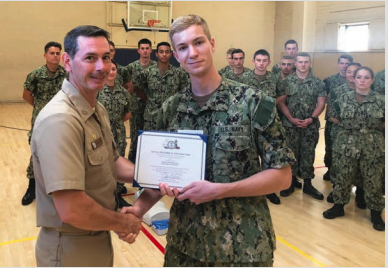Though he grew up in a military family, Chris Rielage ’21 initially aspired to serve at the U.S. State Department, practicing diplomacy. Now he’s doing drills and grueling physical training to join the U.S. Navy. And he’s doing that training at UC Berkeley, two hours away from his classes at Stanford.
So, what changed?
“The military, especially the Navy, is the spearhead of our diplomatic efforts,” Rielage wrote in an email to The Daily. “With our closest allies, it’s our military, from the Navy’s assistance over the recent nuclear disaster in Japan to our Army’s constant presence in Korea, that reaffirms how much we value them … I couldn’t, in good conscience, make policy decisions without having seen what impact they had on the ground.”
As a midshipman, Rielage is obligated to spend eight years in the Navy after he graduates: five in the fleet and three more in the reserves. After that, he isn’t sure what he’ll do.
“Who knows? I may take the Foreign Service exam and become a diplomat like I originally planned,” he wrote.
As zealous as he is about his naval pursuits, Rielage is faced with a challenging college life, particularly in balancing his life as a full-time student at Stanford and a midshipman at UC Berkeley’s Navy Reserve Officer Training Corps (NROTC).
Stanford does not offer NROTC training on its campus, challenging students to budget time for two-hour commutes to and from Berkeley. Other challenges of NROTC life are more intense.
“The physical standards are also much higher than the average Stanford student is used to,” Rielage wrote. “We’ve had more than one student fail their first PT test, and have to go into extra training or risk getting dropped from the program.”
Rielage believes the NROTC program for Stanford students is “uniquely punishing.”
“The impact on your class schedule is quite serious, both from the mandatory classes and all the time that training takes up, and to make it worse, Stanford won’t count Naval Science classes as anything more than ‘Pass/Fail’ credits,” he wrote. “There’s also only a few midshipmen on campus at any given time … so there’s very little support network.”
In facing these challenges, Rielage said he has shaped himself into a leader and problem solver.
His academic advisor, Lieutenant Christopher Reilly, said he saw Rielage as an academically impressive student from the start. As time progressed, Rielage developed into a trustworthy leader and one who can “command respect from his classmates,” Reilly said.
“[Reilage] always wants to dig into the root causes and find the underlying principles,” Reilly said. “He makes connections and expands on any nugget of information he is given. His ability to run with an idea and see the impacts down the road are unmatched.”
Despite the difficulty of his life as an NROTC student, Reilage wrote that he is confident in himself and proud of his accomplishments.
“At the end of the day, [the Navy] really is the coolest job in the world,” Reilage wrote. “I get to work with some of the smartest, and more importantly, most selfless people in our country. At Stanford, we may talk about our desire to serve something bigger than ourselves — our sailors live that desire, every single day.”
Contact Jayanth Naga Sai Pasupulati at jayanthnagasai91 ‘at’ gmail.com.
